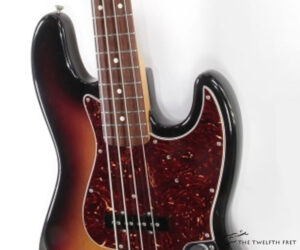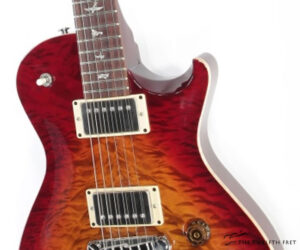The Fender American Vintage ’62 Jazz Bass was built from 1999 to 2002. As part of the American Vintage series, this bass reprises the early specifications of the highly influential successor to the revolutionary Precision bass.
Rosewood
Built from 1991 to 2003 in Memphis, the Gibson ES-135 P100 was a single Florentine cutaway, semi-hollow thinline with a pair of P100 hum-cancelling pickups. From 1956 to 1958, the ES-135 existed as a renamed ES-130, a full-depth, single-cutaway archtop with one or two P-90 pickups. The ES-130 was introduced in 1954, renamed in 1956 to the ES-135, and discontinued in 1958.
This PRS SC-245 10 Top in dark cherry sunburst is a thing of beauty, in very good clean and original condition. The SC-245 model has been in and out of production twice, from 2007 to 2009 and then 2013 to 2016.
Here we’re looking at a first-year PRS SC-245 10 Top, built during 2007 in Stevensville, Maryland. Based on the Singlecut body design, this guitar has a spectacular, highly figured bookmatched Quilted Maple top on a Mahogany back.
The Cromwell G-4 archtop guitar was built by Gibson from 1935 to 1939 and sold to various retailers and catalog distributors. Inside this guitar, visible through the bass F-hole is a well-preserved yellow label reading ‘New York Band Instrument Company’ indicating that it was sold by that company, at the time a large music store in New York City, but gone by 1950.
Here’s a Gibson Les Paul Standard Cherry Sunburst dating to October 22, 1980, sporting a Cherry Sunburst finish and a non-weight relieved, non-pancake body! The Les Paul model was introduced in 1952 as Gibson’s entry into the then-new solidbody ‘Spanish’ electric guitar field, where ‘Spanish’ refers to the way the guitar is held.
The Gibson Les Paul Special TV model appeared in 1955, with the ‘TV’ referring to a special ‘limed’ finish intended to make the guitar more visible on black and white televisions and films. This finish had become available in 1954 on the Les Paul TV, a single-pickup Les Paul Junior. Both models used a slab Mahogany body with no Maple cap, and a Mahogany neck, with a bound Rosewood fingerboard, which into the mid 1960’s meant Brazilian Rosewood.






